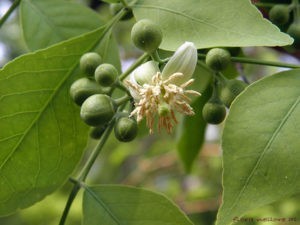Scientific Name: Aegle marmelos
English common name: Bael fruit, Bengal quince
Lao name: maek toum
Plant family: Rutaceae (Citrus family)
This tree is of average height around 6-8 metres tall. The flowers are aromatic and have a strong scent, blooming at the beginning of the rainy season (July – September). It takes nearly a year for its yellow-green fruit, the about the size of a large orange, to grow and ripen.
The fresh pulp of the fruit is edible but you must be careful when eating it to avoid contact with its very sticky sap. In the past, people made glue from the fruit’s gummy secretion.

Cut open fruit.
In Laos, the dried fruit is mainly used to make a tea (served hot or cold) with a mild liquorice flavour; elsewhere, the colourful oranges slices of maek toum are most effective in dried decorative arrangements. The young leaves can be eaten with laap (a traditional Lao salad dish of finely minced meat and herbs).
As a herbal plant, the Bael fruit is considered to have numerous medicinal virtues. Some of them are as follows (information kindly provided by Dr. Souk Aloun): the roots are used to fight fever and abscesses, the green fruit helps the appetite, the ripe fruit helps the digestion, dried fruit is good for the liver; it is thought that the young leaves may have contraceptive properties, and that the bark might calm heart palpitations.

Tree, cut and uncut fruit.
This tree is little used in Laos compared to the level of use elsewhere. For example, in many areas of India the ripened fruit is used in the food-processing industry to produce jams and juices, the young fruit is used to dye fabrics yellow and to manufacture bath oils. Above all, it is a sacred tree, dedicated to the god Shiva, to whom devotees offer its leaves.
Text by Dr Biba Vilaylek, PTK Ethnobotanist. Translation from French kindly done by Gillian Marshall. Edits by Bryony Smart, PTK Botanist.
Photo credits:
Photograph of cut open fruit by Asit K. Ghosh Thaumaturgist – Own work, CC BY-SA 3.0, https://commons.wikimedia.org/w/index.php?curid=10298416
Photograph showing tree, cut fruit and whole fruit by GFDL [CC BY-SA 3.0 (https://creativecommons.org/licenses/by-sa/3.0)], via Wikimedia Commons
Photograph of flowers by Lalithamba – Flickr: Aegle marmelos (L.)Correa, CC BY 2.0, https://commons.wikimedia.org/w/index.php?curid=32065986

The flowers are similar to those of other citrus trees like oranges.



